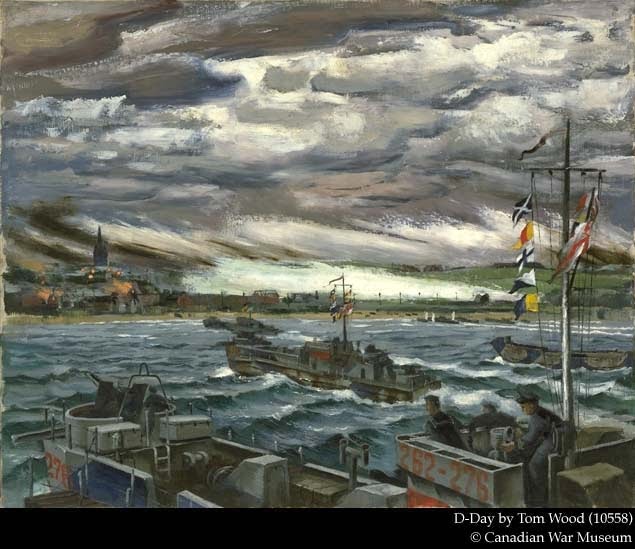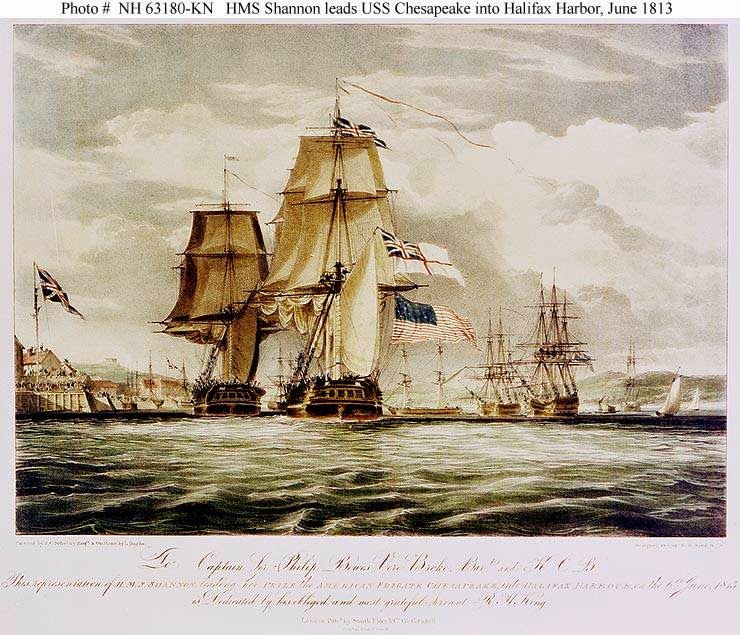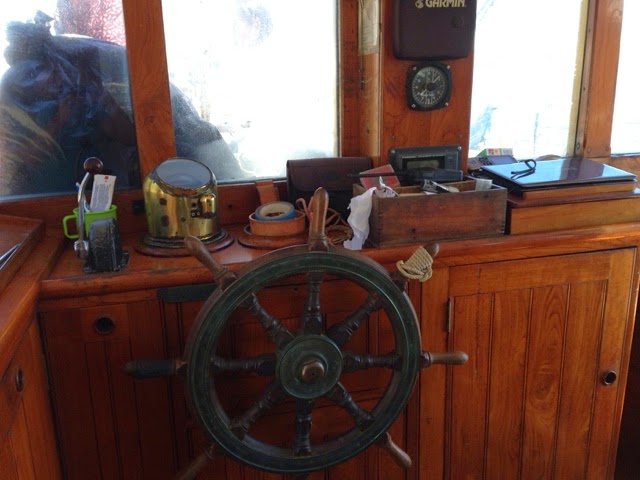In the painting D-Day (CWM 10558) the atmosphere is almost festive as landing craft of the 262nd Canadian Flotilla bring infantry into Bernières-sur-Mer. The Artist, Tom Wood, Served with the Navy, and was present for the landings.
Author Archives: Peter Ziobrowski
200 Years ago Today..
Colored lithograph by L. Haghe, after a painting by J.C. Schetky based on a design by Captain R.H. King, RN. Published by Smith, Elder & Company, London, in 1830.
Courtesy of the U.S. Naval Academy Museum, Annapolis, Maryland. Beverly R. Robinson Collection. The series is dedicated to Captain Philip Bowes Vere Broke, R.N., Shannon’s Commanding Officer. U.S. Naval History and Heritage Command Photograph
Halifax Shipyard’s Graving Dock now a National Historic Civil Engineering Site
Today the Canadian Society for Civil Engineering (CSCE) officially designated the Halifax Shipyard’s Graving Dock as a National Historic Civil Engineering Site. Now owned by Irving Shipbuilding, the large dry dock was constructed in the 1880s for shipbuilding and repairs. It has functioned during two World Wars and is still serving the industry today. According to the CSCE’s Program of Designation, the 173-metre-long and 24-metre-wide graving dock is a remarkable engineering accomplishment: at 125 years old it is still performing, essentially according to its original design. At the time of its construction, it was the largest dry dock on the Eastern Seaboard and could handle the world’s largest vessels.
The Graving Dock remains a critical part of Irving Shipbuilding’s operation to this day. Currently in dock is HMCS St. John’s, one of the Canadian Navy’s Halifax-Class frigates. Originally Irving-built at Saint John Shipbuilding, seven of these ships are now in the midst of a refit program. It can take anywhere from 12 – 18 months to complete each ship. The program began in 2011 and will continue into 2017.
It is fitting that the Graving Dock has been recognized for its significance from a historical civil engineering stand-point. It has survived the Halifax Explosion, several World Wars, and the inevitable advancement of the industry from wooden to steel ships as well as the exponential growth in vessel size and weight. It helped repair several thousand ships during World War II and now is the repair site for our Navy’s current combatant fleet, in the very shipyard that will construct the Navy’s new combatant fleet beginning in 2015.
The Ocean terminals At pier 20 are also Registered as a National Historic Civil Engineering Site
FELEX Update – HMCS Charlottetown Back to the Navy
HMCS Charlottetown is being handed back to the navy today, having completed the shipyard portion of her Felix refit. HMCS St Johns should take her place at the Machine Shop Wharf shortly.
Another random charter for Hapag Lloyd
Today brought the arrival of Quadriga to Fairview Cove. Built in 2008, she carries 3400TEU which is considerably smaller then the vessels they normally run. The recent changes may just be due to periodic maintenance, or Hapag is shuffling vessels due to new 14000TEU new-builds coming on line, and additional capacity to Halifax via the G6 Alliance.
Schwalbe from Southampton. 1600miles off Course.
UPDATE:Normally a post doesn’t illicit urgent calls from the National Post. This one did, however, and so I went to talk to the Owners.
Schwalbe set sail from the Bahamas 32 days ago,with a plan to head to Bermuda, then great circle route to the UK. On the Way she encountered 60knot winds and high waves, and was blown 1600 nautical miles off course. She put into Halifax on Sunday. while underway the Container ship APL Tourmaline manged to transfer fuel and supplies via a 200′ line, and notify Canadian Authorities of the Schwalbe’s destination and eta. Another Vessel also was able to render assistance.
Still Noticeably shaken as he spoke to me, Charlie credits the boat with his survival at sea. Their ordeal cost them several pieces of rigging, including the Topmast which is snapped off. The plan is to sail Thursday for Lunenburg, where they will affect repairs, which they expect will take the remainder of the season.
Googleing told me the Following: Schwalbe was built in Germany in 1927, 2.25” Oak planks on Oak frames, its 57ft on the water line and about 80ft long Overall. She was once Used for fishing, and was cut in half and and an extra 4m added. as late as 2008 she was schooner riged, however the after mast was removed. I also found the video Below of her.
First visit for Bahri Jazan
Spanish Mist
The Tug Spanish Mist is currently nestled up at pier 24. She arrived Saturday from a work period in Methegan.
The tug formerly worked for Fundy Gypsum, and was used to assist ships tieing up at their Hantsport. Dock. When that operation shut down in 2011, the tug was sold.
She is now owned by I.M Tug of Quebec, and is Registered in Halifax. She was Built in 1981 by ASTILLEROS ARDEAG S.A of Bilbao Spain.
M/V Miner Removal Contract Awarded.
The Nova Scotia Government today announced that RJ MacIsaac Construction, an Antigonish-based company, was awarded the contract to remove the ship by November. The work is estimated to cost $11.9 million.
RJ MacIsaac Construction was one of seven companies that responded to the Request for Proposals (RFP) in March. The bidding process closed April 29.
The proposals were reviewed by a panel of experts to help ensure a fair and transparent process. The panel included representation from the provincial and federal governments, including health and safety officers, officials from the Department of Environment, the provincial procurement office, and Transport Canada.
A point system was used to evaluate the bids considering many factors, including price, method of removal, occupational health and safety considerations, environmental consideration, and worker accommodation. Prospective bidders were made aware of the process, the criteria, and the point system during a mandatory meeting held in advance of the RFP launch.
RJ MacIsaac has until November to remove the wreck. They will work with the province to develop a project schedule. The community will be kept up to date on the project’s timeline.
Next Steps in Shell Exploration
After last years Seismic work for shell (This years fleet is under contract to BP) Shell has announced they have chartered the Stena Icemax to drill 7 test wells in the 2015 season. The vessel is Currently working in the Gulf of Mexico.
Shell has also contracted Furgo GeoSurveys to perform a seabed survey, to identify drilling sites and hazards on the sea floor. this is approximately 45days of work, and Furgo will use the Coriolis II (Currently tied up at Pier 9) to do the work this summer.









